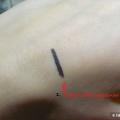Fresher
We owe the tanning fashion to Coco Chanel. Not so long ago, it was considered a sign of the lower class, but today people go to tanning salons for the cherished tan and can distinguish a Black Sea tan from a Thai tan.
What is tanning?
 Sunburn is a darkening of the skin due to the production of melanin pigment in the upper layer of the skin - the epidermis, 5% of which is melanocytes. Under the influence of ultraviolet radiation, the amino acid tyrazine is consumed. This is how melanin is produced, which controls the effect of ultraviolet radiation on the skin. Each person has an equal number of melanocytes - about 5 million, but their activity is individual. Therefore, the color of the skin and sunburn is different for people. Not everyone knows about this, but animals, plants, and even microorganisms also have melanin. It comes in black (eumelanin), yellow (pheomelanin), and brown (phacomelanin). It is because of melanin that beans and grape seeds darken, peeled potatoes darken, and banana peels turn black. Melanin stains the chitin of insects and gives the characteristic color to plants.
Sunburn is a darkening of the skin due to the production of melanin pigment in the upper layer of the skin - the epidermis, 5% of which is melanocytes. Under the influence of ultraviolet radiation, the amino acid tyrazine is consumed. This is how melanin is produced, which controls the effect of ultraviolet radiation on the skin. Each person has an equal number of melanocytes - about 5 million, but their activity is individual. Therefore, the color of the skin and sunburn is different for people. Not everyone knows about this, but animals, plants, and even microorganisms also have melanin. It comes in black (eumelanin), yellow (pheomelanin), and brown (phacomelanin). It is because of melanin that beans and grape seeds darken, peeled potatoes darken, and banana peels turn black. Melanin stains the chitin of insects and gives the characteristic color to plants. What is a tan?
If you look at the employees returning from summer vacations in the fall, you can recognize which of them vacationed where. The most intense tan is marine. It has a characteristic golden brown hue. The difference between sea tanning is that at sea a person receives not only doses of direct, but also reflected ultraviolet radiation, so you need to sunbathe at sea carefully, preferably in the morning and evening hours, avoiding long exposure to the sun in the middle of the day. The second most intense type of tanning is the river tan. It differs from the marine color, and also in that it lasts longer, since exposure to moderate sun has a cumulative effect. Finally, there is a tanning salon and self-tanning. The latter is not really a tan. This is a stimulation by the substances that make up the self-tanner of the keratin protein contained in the epidermis, which causes it to change color.When did tanning come into fashion?
 Until the 20s of the last century, tanning was not in trend and was considered a sign of the lower class. History connects the fashion for tanning with Coco Chanel, who, after returning from a Mediterranean holiday, was an atypical bronze color for the aristocracy. In the summer of 1922, she officially announced to reporters that an aspirin-colored face (which the delicate salon ladies were so proud of) looked unhealthy and unpleasant, and beautiful skin was tanned skin. This announcement changed a lot, turning the fashion industry upside down. Closed bathing suits began to go out of fashion, the appearance of a bikini was not far off. However, in fairness, it must be said that the story with Coco is part of a big myth, since tanning for medicinal purposes has been used for a long time for this, and not just anywhere, but in Russia. Although the term "sunbathing" itself was introduced by the French doctor Rikli back in 1855, this procedure did not gain popularity in the doctor's homeland, but sunbathing became popular with all foreign trends of the Russian aristocracy already in the 70s of the 19th century.
Until the 20s of the last century, tanning was not in trend and was considered a sign of the lower class. History connects the fashion for tanning with Coco Chanel, who, after returning from a Mediterranean holiday, was an atypical bronze color for the aristocracy. In the summer of 1922, she officially announced to reporters that an aspirin-colored face (which the delicate salon ladies were so proud of) looked unhealthy and unpleasant, and beautiful skin was tanned skin. This announcement changed a lot, turning the fashion industry upside down. Closed bathing suits began to go out of fashion, the appearance of a bikini was not far off. However, in fairness, it must be said that the story with Coco is part of a big myth, since tanning for medicinal purposes has been used for a long time for this, and not just anywhere, but in Russia. Although the term "sunbathing" itself was introduced by the French doctor Rikli back in 1855, this procedure did not gain popularity in the doctor's homeland, but sunbathing became popular with all foreign trends of the Russian aristocracy already in the 70s of the 19th century. Precautions
Sunburn, as you know, can be not only useful, but also harmful. Excessive sun exposure can cause a host of complications, from sunburn and heatstroke to cancer problems. Therefore, you need to sunbathe moderately and wisely. Morning hours (from 8 to 11) and evening (from 16 to 19) are considered safe for sunburn. Ultraviolet rays consist of three types - A, B, C. It is believed that when passing through the earth's atmosphere, the most dangerous C and B rays are retained by natural filters, and A rays do not pose a great danger. In fact, given the state of the ozone layer, we can say that not all B and C rays are delayed, so in the daytime, when ultraviolet rays are especially intense, it is better to rest in the shade.What is there so as not to burn out
 For an even tan, as well as in order to prevent the harmful effects of UV rays, doctors advise adhering to a special diet that can help the body cope with ultraviolet light. There are several foods that are preferable to eat in the sun. Oddly enough, firstly, it is dark chocolate. Research has shown that dark chocolate is high in health-promoting flavonoids that increase skin elasticity and firmness. These substances strengthen blood vessels and are a good prevention of heart attacks. The chocolate must be bitter. With a cocoa content of at least 65%. Beta-carotene contained in carrots, sweet potatoes, apricots, pumpkin and mango is actively promoted by manufacturers of cosmetics. And for good reason, because this substance acts as a protector for plants, preventing radicals from destroying their cells. Once in the human body, beta-carotene acts in a similar way, preventing external and internal damage, including protecting the skin from the sun's rays. Tomatoes, watermelons, and papaya contain a substance called lycopene. This compound is used to fight cancer cells, asthma, and cataracts. Strawberries, kiwi, oranges, almonds and salmon are also useful for lovers of hot holidays. Drinking in the sun is best done with plain water, natural juices, and green tea. The latter contains a substance called by physicians "epigallocatechin gallate". It is a natural chemical that helps speed up metabolism, fast weight loss and protection from ultraviolet radiation. In addition, EGCG has been noted to have properties in the prevention of Alzheimer's disease. Green tea also inhibits the increased production of histamine, thereby minimizing allergic reactions that can ruin any vacation.
For an even tan, as well as in order to prevent the harmful effects of UV rays, doctors advise adhering to a special diet that can help the body cope with ultraviolet light. There are several foods that are preferable to eat in the sun. Oddly enough, firstly, it is dark chocolate. Research has shown that dark chocolate is high in health-promoting flavonoids that increase skin elasticity and firmness. These substances strengthen blood vessels and are a good prevention of heart attacks. The chocolate must be bitter. With a cocoa content of at least 65%. Beta-carotene contained in carrots, sweet potatoes, apricots, pumpkin and mango is actively promoted by manufacturers of cosmetics. And for good reason, because this substance acts as a protector for plants, preventing radicals from destroying their cells. Once in the human body, beta-carotene acts in a similar way, preventing external and internal damage, including protecting the skin from the sun's rays. Tomatoes, watermelons, and papaya contain a substance called lycopene. This compound is used to fight cancer cells, asthma, and cataracts. Strawberries, kiwi, oranges, almonds and salmon are also useful for lovers of hot holidays. Drinking in the sun is best done with plain water, natural juices, and green tea. The latter contains a substance called by physicians "epigallocatechin gallate". It is a natural chemical that helps speed up metabolism, fast weight loss and protection from ultraviolet radiation. In addition, EGCG has been noted to have properties in the prevention of Alzheimer's disease. Green tea also inhibits the increased production of histamine, thereby minimizing allergic reactions that can ruin any vacation.  How to have the perfect date when you're not romantic
How to have the perfect date when you're not romantic What diseases do you need to drink coffee - benefits and effects
What diseases do you need to drink coffee - benefits and effects All my brown eyeliners
All my brown eyeliners